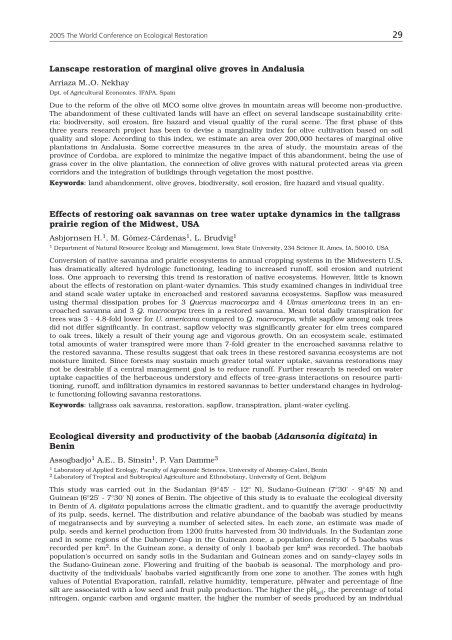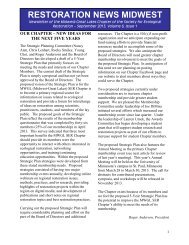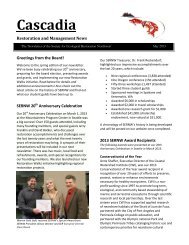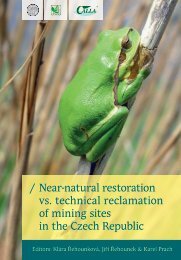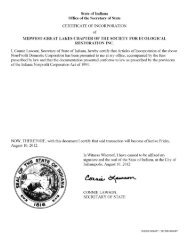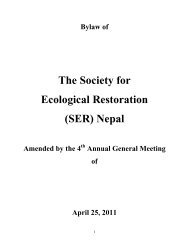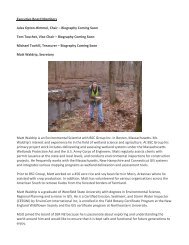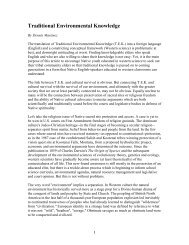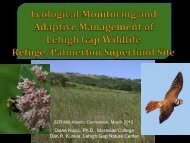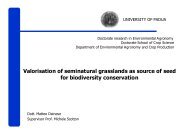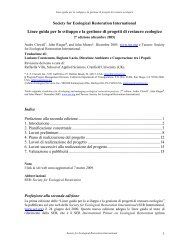THE WORLD CONFERENCE ON ECOLOGICAL RESTORATION
A Global Challenge - Society for Ecological Restoration
A Global Challenge - Society for Ecological Restoration
You also want an ePaper? Increase the reach of your titles
YUMPU automatically turns print PDFs into web optimized ePapers that Google loves.
2005 The World Conference on Ecological Restoration 29<br />
Lanscape restoration of marginal olive groves in Andalusia<br />
Arriaza M.,O. Nekhay<br />
Dpt. of Agricultural Economics. IFAPA. Spain<br />
Due to the reform of the olive oil MCO some olive groves in mountain areas will become non-productive.<br />
The abandonment of these cultivated lands will have an effect on several landscape sustainability criteria:<br />
biodiversity, soil erosion, fire hazard and visual quality of the rural scene. The first phase of this<br />
three years research project has been to devise a marginality index for olive cultivation based on soil<br />
quality and slope. According to this index, we estimate an area over 200,000 hectares of marginal olive<br />
plantations in Andalusia. Some corrective measures in the area of study, the mountain areas of the<br />
province of Cordoba, are explored to minimize the negative impact of this abandonment, being the use of<br />
grass cover in the olive plantation, the connection of olive groves with natural protected areas via green<br />
corridors and the integration of buildings through vegetation the most positive.<br />
Keywords: land abandonment, olive groves, biodiversity, soil erosion, fire hazard and visual quality.<br />
Effects of restoring oak savannas on tree water uptake dynamics in the tallgrass<br />
prairie region of the Midwest, USA<br />
Asbjornsen H. 1 , M. Gómez-Cárdenas 1 , L. Brudvig 1<br />
1 Department of Natural Resource Ecology and Management, Iowa State University, 234 Science II, Ames, IA, 50010, USA<br />
Conversion of native savanna and prairie ecosystems to annual cropping systems in the Midwestern U.S.<br />
has dramatically altered hydrologic functioning, leading to increased runoff, soil erosion and nutrient<br />
loss. One approach to reversing this trend is restoration of native ecosystems. However, little is known<br />
about the effects of restoration on plant-water dynamics. This study examined changes in individual tree<br />
and stand scale water uptake in encroached and restored savanna ecosystems. Sapflow was measured<br />
using thermal dissipation probes for 3 Quercus macrocarpa and 4 Ulmus americana trees in an encroached<br />
savanna and 3 Q. macrocarpa trees in a restored savanna. Mean total daily transpiration for<br />
trees was 3 - 4.8-fold lower for U. americana compared to Q. macrocarpa, while sapflow among oak trees<br />
did not differ significantly. In contrast, sapflow velocity was significantly greater for elm trees compared<br />
to oak trees, likely a result of their young age and vigorous growth. On an ecosystem scale, estimated<br />
total amounts of water transpired were more than 7-fold greater in the encroached savanna relative to<br />
the restored savanna. These results suggest that oak trees in these restored savanna ecosystems are not<br />
moisture limited. Since forests may sustain much greater total water uptake, savanna restorations may<br />
not be desirable if a central management goal is to reduce runoff. Further research is needed on water<br />
uptake capacities of the herbaceous understory and effects of tree-grass interactions on resource partitioning,<br />
runoff, and infiltration dynamics in restored savannas to better understand changes in hydrologic<br />
functioning following savanna restorations.<br />
Keywords: tallgrass oak savanna, restoration, sapflow, transpiration, plant-water cycling.<br />
Ecological diversity and productivity of the baobab (Adansonia digitata) in<br />
Benin<br />
Assogbadjo 1 A.E., B. Sinsin 1 , P. Van Damme 3<br />
1 Laboratory of Applied Ecology, Faculty of Agronomic Sciences, University of Abomey-Calavi, Benin<br />
2 Laboratory of Tropical and Subtropical Agriculture and Ethnobotany, University of Gent, Belgium<br />
This study was carried out in the Sudanian (9°45' - 12° N), Sudano-Guinean (7°30' - 9°45' N) and<br />
Guinean (6°25' - 7°30' N) zones of Benin. The objective of this study is to evaluate the ecological diversity<br />
in Benin of A. digitata populations across the climatic gradient, and to quantify the average productivity<br />
of its pulp, seeds, kernel. The distribution and relative abundance of the baobab was studied by means<br />
of megatransects and by surveying a number of selected sites. In each zone, an estimate was made of<br />
pulp, seeds and kernel production from 1200 fruits harvested from 30 individuals. In the Sudanian zone<br />
and in some regions of the Dahomey-Gap in the Guinean zone, a population density of 5 baobabs was<br />
recorded per km 2 . In the Guinean zone, a density of only 1 baobab per km 2 was recorded. The baobab<br />
population’s occurred on sandy soils in the Sudanian and Guinean zones and on sandy–clayey soils in<br />
the Sudano-Guinean zone. Flowering and fruiting of the baobab is seasonal. The morphology and productivity<br />
of the individuals’ baobabs varied significantly from one zone to another. The zones with high<br />
values of Potential Evaporation, rainfall, relative humidity, temperature, pHwater and percentage of fine<br />
silt are associated with a low seed and fruit pulp production. The higher the pH kcl<br />
, the percentage of total<br />
nitrogen, organic carbon and organic matter, the higher the number of seeds produced by an individual


